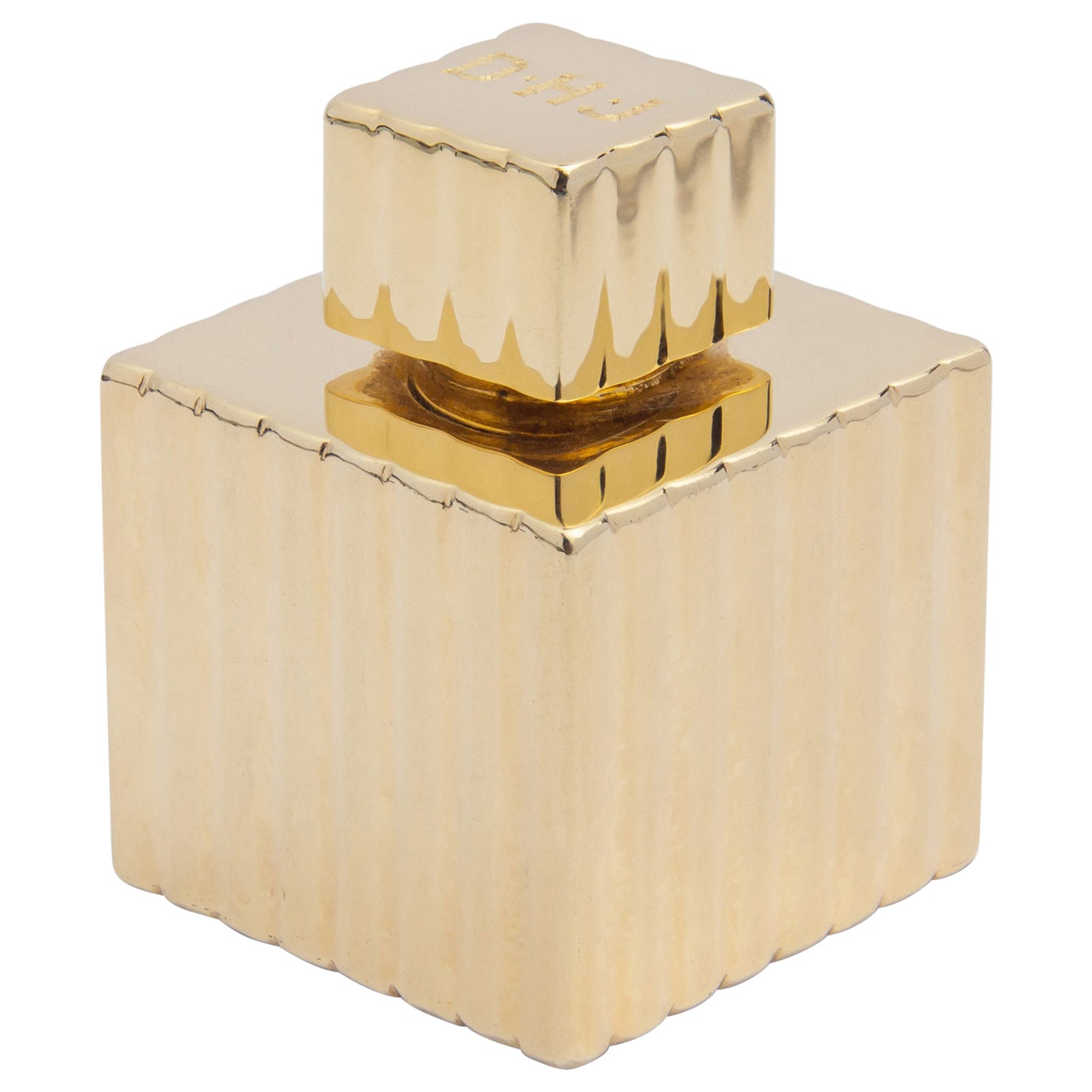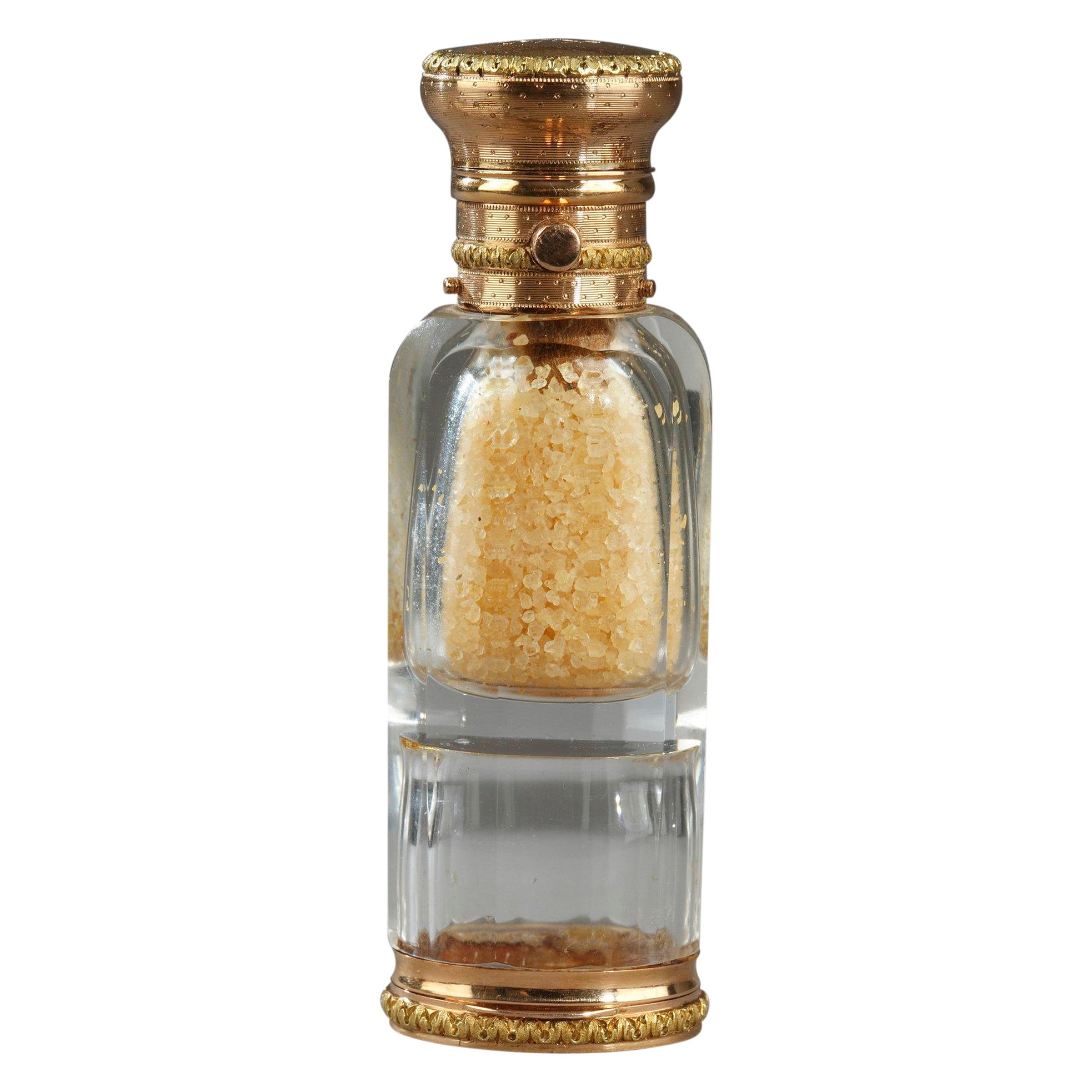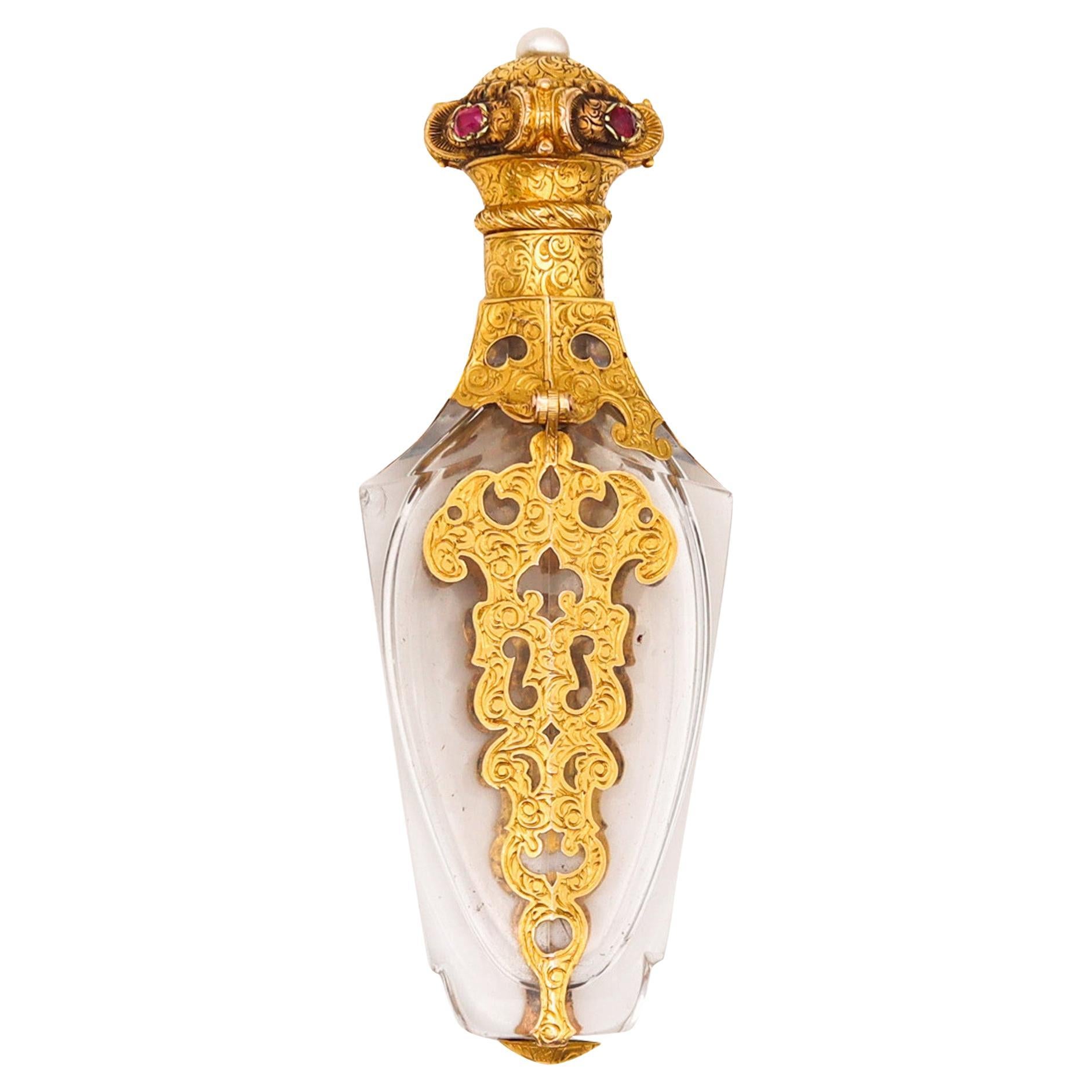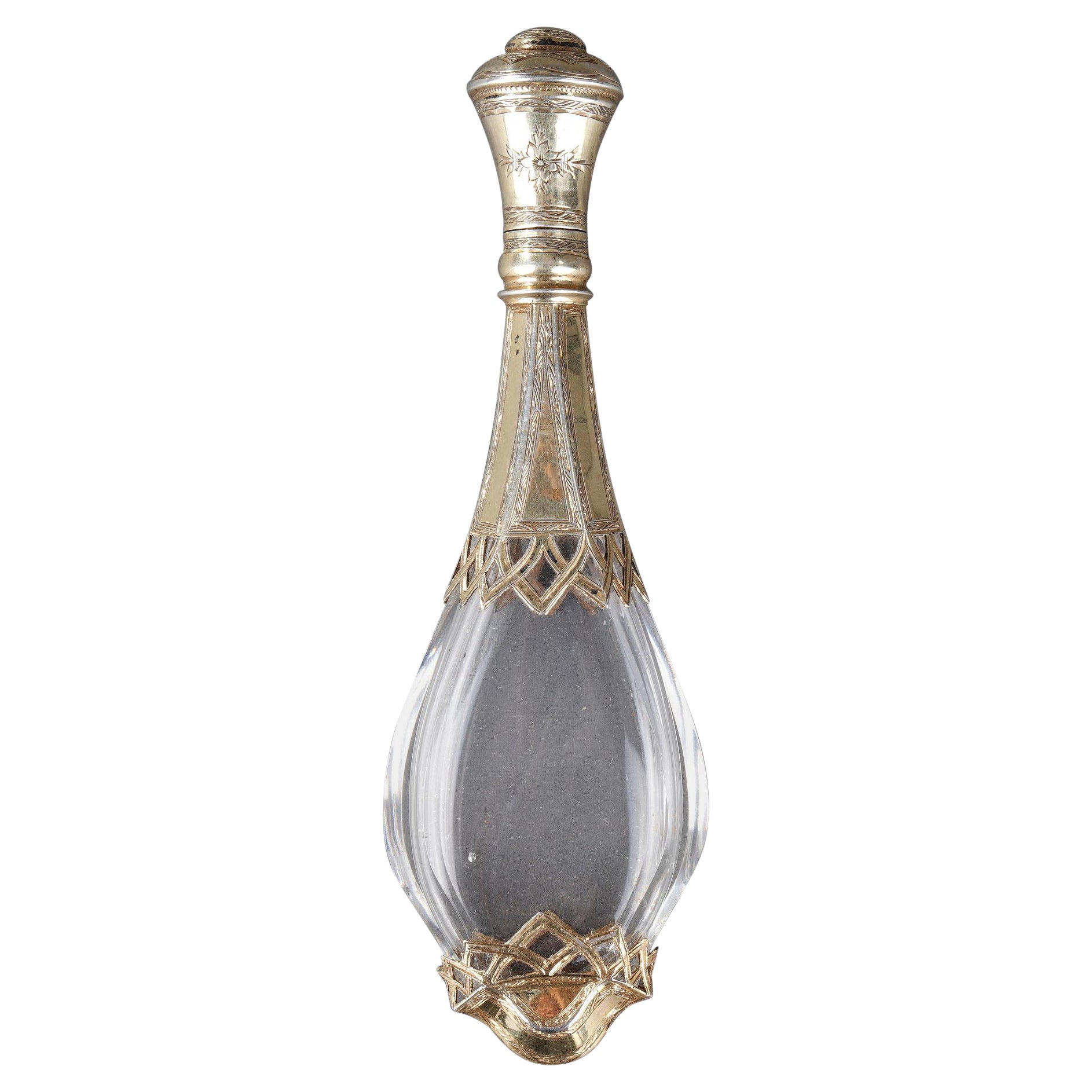Tiffany & Co 1905 Edwardian Essex Glass Scent Bottle 18kt Gold and Rock Quartz
About the Item
- Creator:
- Metal:
- Stone:
- Stone Cut:
- Weight:137.5 g
- Dimensions:Height: 3.15 in (80.01 mm)Width: 1.54 in (39.12 mm)Depth: 1.37 in (34.8 mm)
- Style:
- Place of Origin:
- Period:
- Date of Manufacture:1905
- Condition:Wear consistent with age and use. The overall condition of this bottle is excellent. Beside the little normal wear, there is no damage to the gold, have a small rim nick in the bottom. This piece has been carefully inspected to guarantee the condition and authenticity.
- Seller Location:Miami, FL
- Reference Number:
Tiffany & Co.
Tiffany & Co. is one of the most prominent purveyors of luxury goods in the United States, and has long been an important arbiter of style in the design of diamond engagement rings. A young Franklin Delano Roosevelt proposed to his future wife, Eleanor, with a Tiffany ring in 1904. Vanderbilts, Whitneys, Astors and members of the Russian imperial family all wore Tiffany & Co. jewels. And Jacqueline Kennedy Onassis preferred Tiffany china for state dinners at the White House.
Although synonymous with luxury today, the firm started out rather modestly. Charles Lewis Tiffany and John B. Young founded it in Connecticut as a “stationery and fancy goods emporium” in 1837, at a time when European imports still dominated the nascent American luxury market. In 1853, Charles Tiffany — who in 1845 had launched the company’s famed catalog, the Blue Book, and with it, the firm’s signature robin’s-egg blue, which he chose for the cover — shifted the focus to fine jewelry. In 1868, Tiffany & Co. gained international recognition when it became the first U.S. firm to win an award for excellence in silverware at the Exposition Universelle in Paris. From then on, it belonged to the pantheon of American luxury brands.
At the start of the Gilded Age, in 1870, Tiffany & Co. opened its flagship store, described as a "palace of jewels" by the New York Times, at 15 Union Square West in Manhattan. Throughout this period, its designs for silver tableware, ceremonial silver, flatware and jewelry were highly sought-after indicators of status and taste. They also won the firm numerous accolades, including the grand prize for silverware at the Paris Exposition of 1878. Among the firm’s glittering creations from this time are masterworks of Art Nouveau jewelry, such as this delicate aquamarine necklace and this lavish plique-à-jour peridot and gold necklace, both circa 1900.
When Charles Lewis Tiffany died, in 1902, his son Louis Comfort Tiffany became the firm’s design director. Under his leadership, the Tiffany silver studio was a de facto design school for apprentice silversmiths, who worked alongside head artisan Edward C. Moore. The firm produced distinctive objects inspired by Japanese art and design, North American plants and flowers, and Native American patterns and crafts, adding aesthetic diversity to Tiffany & Co.’s distinguished repertoire.
Tiffany is also closely associated with diamonds, even lending its name to one particularly rare and exceptional yellow stone. The firm bought the Tiffany diamond in its raw state from the Kimberley mines of South Africa in 1878. Cut to create a 128.54-carat gem with an unprecedented 82 facets, it is one of the most spectacular examples of a yellow diamond in the world. In a broader sense, Tiffany & Co. helped put diamonds on the map in 1886 by introducing the American marketplace to the solitaire diamond design, which is still among the most popular engagement-ring styles. The trademark Tiffany® Setting raises the stone above the band on six prongs, allowing its facets to catch the light. A lovely recent example is this circa-2000 platinum engagement ring. Displaying a different design and aesthetic (but equally chic) is this exquisite diamond and ruby ring from the 1930s.
- ShippingRetrieving quote...Ships From: Miami, FL
- Return PolicyA return for this item may be initiated within 1 day of delivery.
- French 1820 Baroque Rock Quartz Scent Perfume Bottle Mount 18k Gold with GemsLocated in Miami, FLFrench scent bottle with gemstones. Gorgeous antique scent perfume bottle, created in France in the first quarter of the 19th century, circa 1820....Category
Antique 1820s French Neoclassical Vanity Items
MaterialsPearl, Natural Pearl, Quartz, Ruby, Gold, 18k Gold, Yellow Gold
- Tiffany & Co 1977 Elsa Peretti Rock Quartz Lilies Clips Earrings In 18Kt GoldBy Elsa Peretti for Tiffany & Co.Located in Miami, FLA lilies earrings designed by Elsa Peretti (1940-2021) for Tiffany & Co. These sculptural pair of clips-on earrings are extremely rare and just a few were produced. They were design...Category
Vintage 1970s American Modernist Clip-on Earrings
MaterialsQuartz, Gold, 18k Gold, Yellow Gold
- French 1870 Napoleon III Perfume Bottle Mount In 18Kt Yellow Gold With GemstonesLocated in Miami, FLFrench scent bottle with gemstones. Gorgeous antique scent perfume bottle, created in Paris France during the imperial period of Napoleon III, back in the 1860. This exceptional bot...Category
Antique 1860s French Napoleon III Vanity Items
MaterialsGarnet, Pearl, Natural Pearl, Gold, 18k Gold, Yellow Gold, Enamel
- French 1900 Edwardian Tortoise Parasol Handle in 18kt Yellow Gold Carved CitrineLocated in Miami, FLEdwardian parasol handle made in France. Very beautiful and elegant piece, created in Paris France during the Edwardian and Belle Epoque periods, back in the 1900. This fabulous parasol handle has been designed with French neo-classic patterns in the style of Louis XVI. Crafted by assembling pieces made up in 18 karats yellow gold, carved citrine and amber color faux tortoise. The baton is fitted with a screw to attach to any parasol or cane. The round gold parts on top are made with multiple leaf motifs, bows, tassels and floral clusters, typical from the Belle Epoque period. Gemstones: The top part is mounted, with 1 cylinder cabochon cut of natural translucent citrine quartz of about 120 carats. Birthstone: Citrine, for the month of November. Weight: 66.95 Grams, (42.91 Dwt). Measurements: 248 mm by 20 mm (9.75 x 0.79 Inches). Hallmarks: Both gold parts are stamped with French marks; the head of the eagle for the assay and warranty of the 18kt gold and the maker's maitre mark inside a lozange cartouche. Edwardian era, like the Georgian and Victorian eras before it, derives its name from the reign of the English King, Edward VII (1901-1910). Edwardian jewelry is known for representing femininity while incorporating a lot of the color white. Think diamonds, pearls and white metals like platinum and white gold. Diamonds often had an Old Mine or European cut and sapphires were a popular choice for a pop of color. They tended to be made from platinum and diamonds – the more, the merrier – and used fashionable, intricate techniques such as filigree and millegrain. Edwardian rings are works of art and best worn alone or alongside a simple wedding band...Category
Antique Early 1900s French Edwardian Vanity Items
MaterialsCitrine, Quartz, Gold, 18k Gold, Yellow Gold
- Edwardian 1905 Belle Epoque Cross In 18Kt Gold With Diamond and SapphireLocated in Miami, FLEdwardian belle époque cross. Beautiful cross from the Belle Epoque period, created during the Edwardian era (1901-1910), back in the 1905. This de...Category
Antique Early 1900s North American Edwardian Pendant Necklaces
MaterialsDiamond, White Diamond, Sapphire, Blue Sapphire, Gold, Yellow Gold, Pall...
- Edwardian 1905 Ring In 18Kt Yellow Gold And Platinum With Diamonds And RubyLocated in Miami, FLEdwardian ring with diamonds and ruby. A beautiful antique ring from the Belle Epoque period, created in England during the Edwardian period, back in the 1905. This stunning ring wa...Category
Antique Early 1900s English Edwardian Engagement Rings
MaterialsDiamond, White Diamond, Ruby, Gold, 18k Gold, Yellow Gold, Platinum
- Amythest and Gold Sulphide Scent Bottle on StandLocated in Riverdale, NYAmythest and 18k Tri Color Gold Sulphide Cameo Scent Bottle on Stand, early 19th Century, possibly by Baccarat. A custom made period stand in sterling allows the bottle to be display...Category
Antique 1820s French Georgian Vanity Items
MaterialsAmethyst, Gold, 18k Gold
- 14 Karat Yellow Gold, Tiffany & Co. Perfume BottleBy Tiffany & Co.Located in Brisbane, QLDThis mid century, solid 14 karat gold perfume bottle was manufactured by Tiffany and Company. Made during the mid 20th century the square form bottle has a ribbed or rippled type finish to the exterior of the piece which is repeated in the square topped applicator which has been engraved with the monogram 'DHJ'. Hallmarked for Tiffany and Company, this small perfume bottle...Category
20th Century American Modernist Vanity Items
MaterialsGold, 14k Gold, Yellow Gold
- Victorian Gold Double-Ended Crystal Scent BottleLocated in Paris, FRA cylindrical, double-ended transparent crystal perfume bottle with one side a fine vinaigrette and the other a smelling salt compartiment. The vinaigre...Category
Antique 1860s English Victorian Vanity Items
MaterialsCrystal, Gold
- Mid-19th Century Silver Mounted Glass Scent BottleLocated in Paris, FRA silver mounted glass scent bottle with shaped baluster body, the part open work collar and foot are pierced and engraved. The circular lid has a s...Category
Antique 1850s French Vanity Items
MaterialsSilver
- Glass Scent Bottle with Gold MountingLocated in Amsterdam, NLA glass scent bottle in the shape of an amphora with a 14 carat gold mounting, foot and stopper and two rings at the side in its original leather ca...Category
Antique 19th Century Dutch Victorian Boxes and Cases
MaterialsGold, 14k Gold
- Gold and Enamel Perfum Bottle, Restauration Period, Circa 1830-1840Located in Paris, FRSmall perfum bottle in gold and enamel. The flask is decorated with palmettes and foliage motifs in white and black enamel on black enamel background. Two gold chains permitted the s...Category
Antique 1830s French Vanity Items
MaterialsGold, Enamel
Recently Viewed
View AllRead More
The Sparkling Legacy of Tiffany & Co. Explained, One Jewel at a Time
A gorgeous new book celebrates — and memorializes — the iconic jeweler’s rich heritage.
15 Scintillating Jewelry Watches to Elevate Your Holiday Style
Watchmakers have tucked their movements into all manner of precious baubles, from lapel pins to cocktail rings. The result is dazzling, wearable art that will get you to the party on time.






